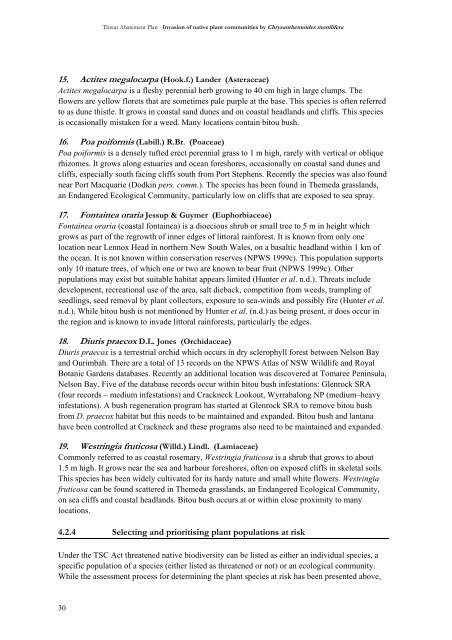NSW Bitou Bush Threat Abatement Plan - Department of ...
NSW Bitou Bush Threat Abatement Plan - Department of ...
NSW Bitou Bush Threat Abatement Plan - Department of ...
You also want an ePaper? Increase the reach of your titles
YUMPU automatically turns print PDFs into web optimized ePapers that Google loves.
30<br />
<strong>Threat</strong> <strong>Abatement</strong> <strong>Plan</strong> - Invasion <strong>of</strong> native plant communities by Chrysanthemoides monilifera<br />
15. Actites megalocarpa (Hook.f.) Lander (Asteraceae)<br />
Actites megalocarpa is a fleshy perennial herb growing to 40 cm high in large clumps. The<br />
flowers are yellow florets that are sometimes pale purple at the base. This species is <strong>of</strong>ten referred<br />
to as dune thistle. It grows in coastal sand dunes and on coastal headlands and cliffs. This species<br />
is occasionally mistaken for a weed. Many locations contain bitou bush.<br />
16. Poa poiformis (Labill.) R.Br. (Poaceae)<br />
Poa poiformis is a densely tufted erect perennial grass to 1 m high, rarely with vertical or oblique<br />
rhizomes. It grows along estuaries and ocean foreshores, occasionally on coastal sand dunes and<br />
cliffs, especially south facing cliffs south from Port Stephens. Recently the species was also found<br />
near Port Macquarie (Dodkin pers. comm.). The species has been found in Themeda grasslands,<br />
an Endangered Ecological Community, particularly low on cliffs that are exposed to sea spray.<br />
17. Fontainea oraria Jessup & Guymer (Euphorbiaceae)<br />
Fontainea oraria (coastal fontainea) is a dioecious shrub or small tree to 5 m in height which<br />
grows as part <strong>of</strong> the regrowth <strong>of</strong> inner edges <strong>of</strong> littoral rainforest. It is known from only one<br />
location near Lennox Head in northern New South Wales, on a basaltic headland within 1 km <strong>of</strong><br />
the ocean. It is not known within conservation reserves (NPWS 1999c). This population supports<br />
only 10 mature trees, <strong>of</strong> which one or two are known to bear fruit (NPWS 1999c). Other<br />
populations may exist but suitable habitat appears limited (Hunter et al. n.d.). <strong>Threat</strong>s include<br />
development, recreational use <strong>of</strong> the area, salt dieback, competition from weeds, trampling <strong>of</strong><br />
seedlings, seed removal by plant collectors, exposure to sea-winds and possibly fire (Hunter et al.<br />
n.d.). While bitou bush is not mentioned by Hunter et al. (n.d.) as being present, it does occur in<br />
the region and is known to invade littoral rainforests, particularly the edges.<br />
18. Diuris praecox D.L. Jones (Orchidaceae)<br />
Diuris praecox is a terrestrial orchid which occurs in dry sclerophyll forest between Nelson Bay<br />
and Ourimbah. There are a total <strong>of</strong> 13 records on the NPWS Atlas <strong>of</strong> <strong>NSW</strong> Wildlife and Royal<br />
Botanic Gardens databases. Recently an additional location was discovered at Tomaree Peninsula,<br />
Nelson Bay. Five <strong>of</strong> the database records occur within bitou bush infestations: Glenrock SRA<br />
(four records – medium infestations) and Crackneck Lookout, Wyrrabalong NP (medium–heavy<br />
infestations). A bush regeneration program has started at Glenrock SRA to remove bitou bush<br />
from D. praecox habitat but this needs to be maintained and expanded. <strong>Bitou</strong> bush and lantana<br />
have been controlled at Crackneck and these programs also need to be maintained and expanded.<br />
19. Westringia fruticosa (Willd.) Lindl. (Lamiaceae)<br />
Commonly referred to as coastal rosemary, Westringia fruticosa is a shrub that grows to about<br />
1.5 m high. It grows near the sea and harbour foreshores, <strong>of</strong>ten on exposed cliffs in skeletal soils.<br />
This species has been widely cultivated for its hardy nature and small white flowers. Westringia<br />
fruticosa can be found scattered in Themeda grasslands, an Endangered Ecological Community,<br />
on sea cliffs and coastal headlands. <strong>Bitou</strong> bush occurs at or within close proximity to many<br />
locations.<br />
4.2.4 Selecting and prioritising plant populations at risk<br />
Under the TSC Act threatened native biodiversity can be listed as either an individual species, a<br />
specific population <strong>of</strong> a species (either listed as threatened or not) or an ecological community.<br />
While the assessment process for determining the plant species at risk has been presented above,
















